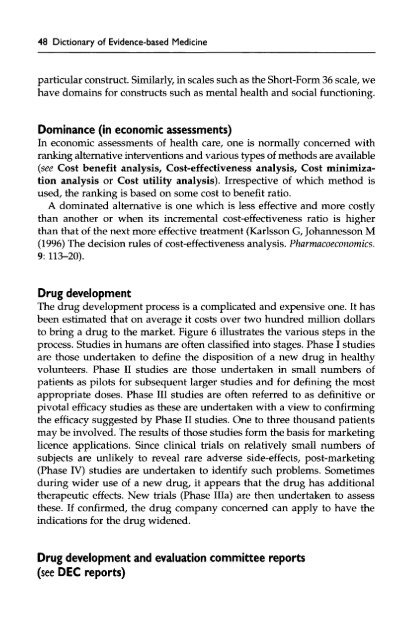Dictionary of Evidence-based Medicine.pdf
Dictionary of Evidence-based Medicine.pdf
Dictionary of Evidence-based Medicine.pdf
Create successful ePaper yourself
Turn your PDF publications into a flip-book with our unique Google optimized e-Paper software.
48 <strong>Dictionary</strong> <strong>of</strong> <strong>Evidence</strong>-<strong>based</strong> <strong>Medicine</strong><br />
particular construct. Similarly, in scales such as the Short-Form 36 scale, we<br />
have domains for constructs such as mental health and social functioning.<br />
Dominance (in economic assessments)<br />
In economic assessments <strong>of</strong> health care, one is normally concerned with<br />
ranking alternative interventions and various types <strong>of</strong> methods are available<br />
(see Cost benefit analysis, Cost-effectiveness analysis, Cost minimization<br />
analysis or Cost utility analysis). Irrespective <strong>of</strong> which method is<br />
used, the ranking is <strong>based</strong> on some cost to benefit ratio.<br />
A dominated alternative is one which is less effective and more costly<br />
than another or when its incremental cost-effectiveness ratio is higher<br />
than that <strong>of</strong> the next more effective treatment (Karlsson G, Johannesson M<br />
(1996) The decision rules <strong>of</strong> cost-effectiveness analysis. Pharmacoeconomics.<br />
9: 113-20).<br />
Drug development<br />
The drug development process is a complicated and expensive one. It has<br />
been estimated that on average it costs over two hundred million dollars<br />
to bring a drug to the market. Figure 6 illustrates the various steps in the<br />
process. Studies in humans are <strong>of</strong>ten classified into stages. Phase I studies<br />
are those undertaken to define the disposition <strong>of</strong> a new drug in healthy<br />
volunteers. Phase II studies are those undertaken in small numbers <strong>of</strong><br />
patients as pilots for subsequent larger studies and for defining the most<br />
appropriate doses. Phase III studies are <strong>of</strong>ten referred to as definitive or<br />
pivotal efficacy studies as these are undertaken with a view to confirming<br />
the efficacy suggested by Phase II studies. One to three thousand patients<br />
may be involved. The results <strong>of</strong> those studies form the basis for marketing<br />
licence applications. Since clinical trials on relatively small numbers <strong>of</strong><br />
subjects are unlikely to reveal rare adverse side-effects, post-marketing<br />
(Phase TV) studies are undertaken to identify such problems. Sometimes<br />
during wider use <strong>of</strong> a new drug, it appears that the drug has additional<br />
therapeutic effects. New trials (Phase Ilia) are then undertaken to assess<br />
these. If confirmed, the drug company concerned can apply to have the<br />
indications for the drug widened.<br />
Drug development and evaluation committee reports<br />
(see DEC reports)










